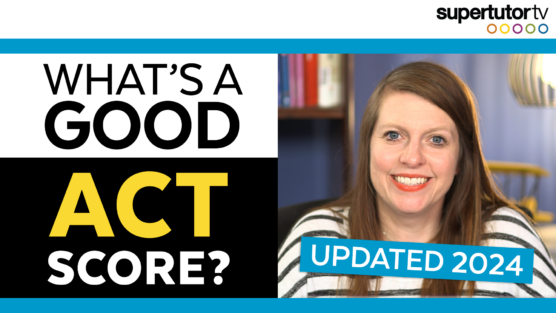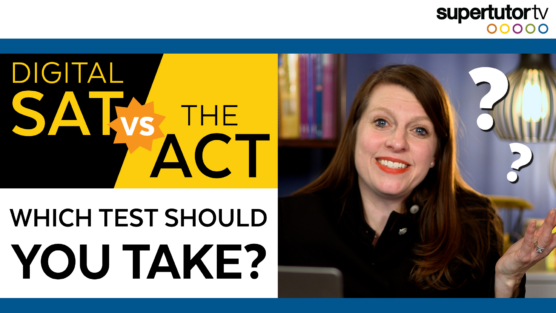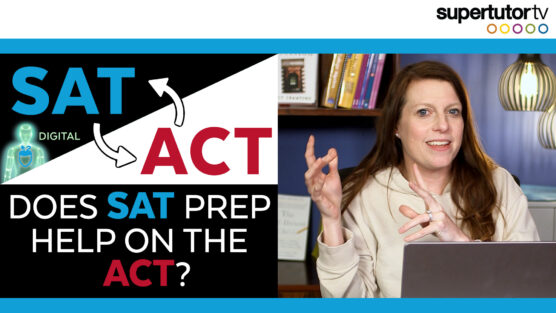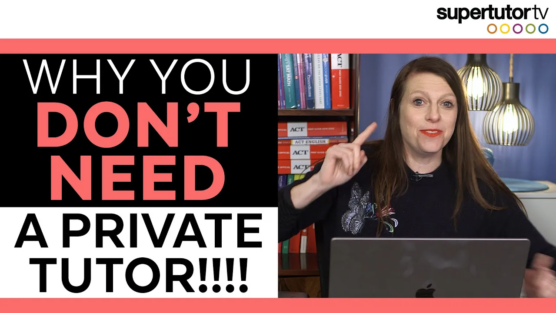Are you taking the ACT® soon and are wondering how you can totally rock the reading section? In this blog, we’re going to go over some of our top tips for how to really get into the ACT® reading section and improve your speed, particularly when reading the passage itself.
This week’s video is excerpted from our online ACT® prep course, The Best ACT® Prep Course Ever, which is available on supertutortv.com. So if you like what you see, go sign up for our course today!
Whether you feel like you struggle with time on the reading section or not, it’s really important that you know how to manage information in passages. It’s not that you have to necessarily think of it as a “reading” section but more as a “passage management” section because what you need to do is manage the information in each passage that you encounter.
1. Try to pick the easiest passage
The easier the prose, the easier it will be to skim. The number one way that we usually find is effective to pick up time is to selectively skim one of the passages that you’re reading. When it comes to skimming the passages, you might want to do things out of order and it’s up to your preference. When it comes to what to skim, we generally don’t find that skimming the narrative/fiction passage is that easy or doable. The one that is the easiest to skim varies from test to test so we recommend you quickly catalog which one seems the easiest to skim if you are going to skim.
2. Read the first and last sentence of each paragraph
This is one way to skim but it can be inflexible and can be flawed. Sometimes reading the first and last sentence doesn’t give you the context you need to know what’s going on, indicating you need to read more. Remember when you skim that you still have to get two important pieces of information: your passage map and main idea/tone.If you can’t get those two things then you need to slow down a bit or improve your skimming techniques. What we like to do is move our eyes over most of the words in a paragraph until we feel like we have the gist or main idea of the paragraph down then move on. Once we understand the argument and the main idea of the paragraph and how the paragraph functions with the passage as a whole then we can proceed. Usually the introductory and concluding paragraphs are helpful in establishing the main idea. However, sometimes the introduction is used as a hook (anecdote/story) and not actually informative to the main idea of the passage so if you see that’s what is going on, then you can skip over the story and see what is the big point of it at the end of it or in the next paragraph.
3. Look for the main ideas
Sometimes the main ideas can’t be found easily in the stories but in other particular areas.
You may find the main idea (most common in the Natural Science passage) in the questions. If you see a question, that usually is something that the passage is revolving around. If the passage outlines an academic study, usually that study will try to answer some question and that’s going to have a question mark at the end of it for you to track. The second thing that we’re looking for is a thesis. The thesis can usually be found in the first few paragraphs and sometimes proceeded by a trigger word. The third place where we can look for the main ideas of a passage is in the answers/conclusions, usually near the end of a passage. Look for what conclusions the author is trying to make after talking through all their ideas.
You can look for trigger words to help you find where the central claims and ideas are. Trigger words are organizational cues like contrast signals (however, although, etc.), information that is added (and, additionally, etc.), words of emphasis (key, critical, etc.) or anything that is trying to tell you what is important to understand. Transitional type of language is also telling and point for you where the text is heading.
4. Recognize the relationship between claims and evidence
What we’re trying to get to as readers if we’re trying to skim is the point, not necessarily the story that proves the point. The main goal is trying to get the claims and once you have that, you can skip over the evidence selectively. You don’t always have to read over all the evidence because if you know what the evidence is proving you still get the author’s point.
5. Skip over lists
Lists are consisted of mostly evidence that can be skipped and save you some time.
Another tip we have is trying not to sub-vocalize. Sub-vocalizing means uttering words or sounds with the lips silently or with barely audible sound, especially when talking to oneself, memorizing something, or reading. Try to avoid doing so when encountering a name or word you are not familiar with and move on.
6. Use speed reading techniques
One of the best tools that you have while going through the section is the ability to change your speed as you go, we go more in depth in our speed reading blog. Main tips when it comes to speed reading is reading in chunks, avoid reading small words, reading with a purpose, circle/underline quickly, and minimizing sub-vocalization.




